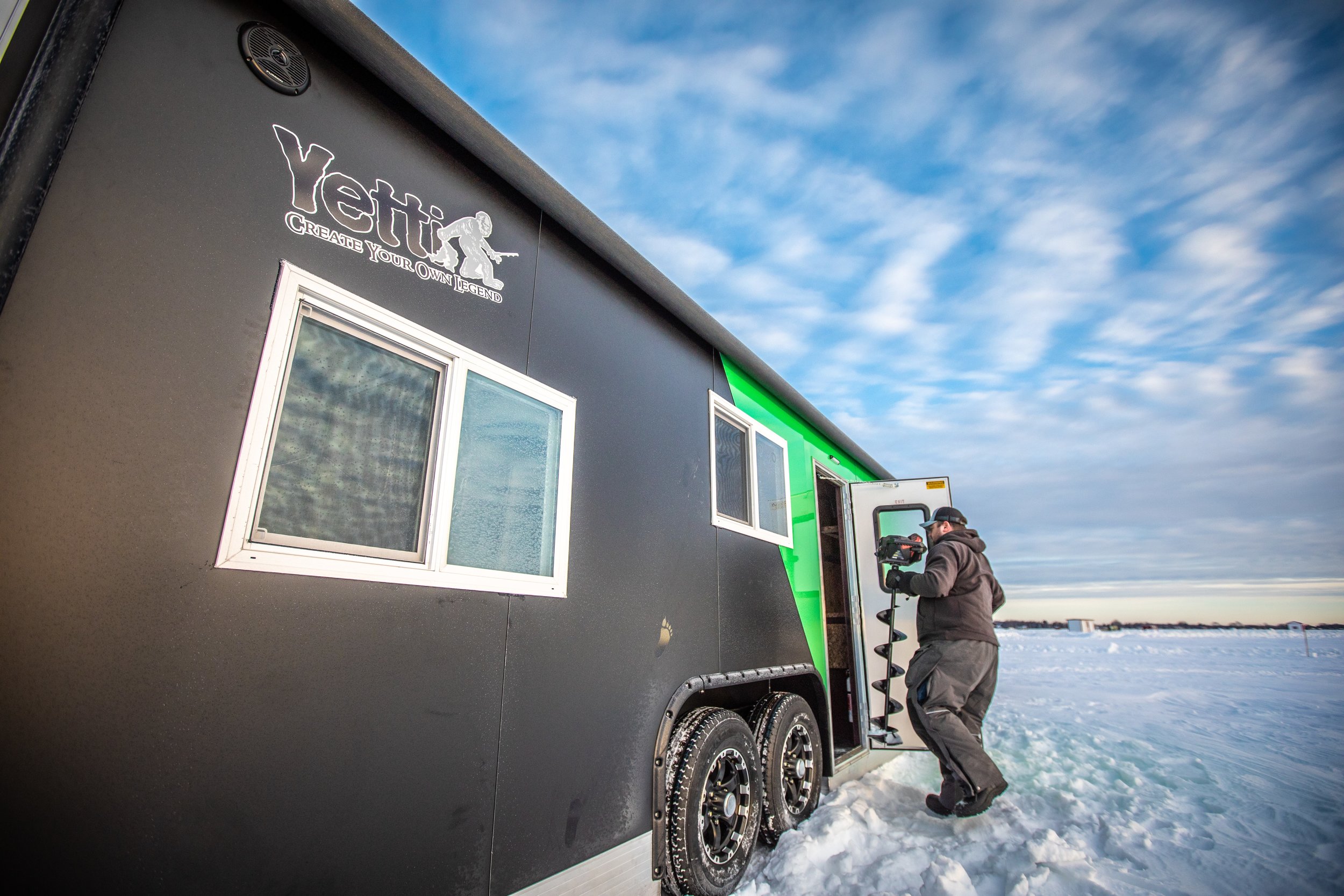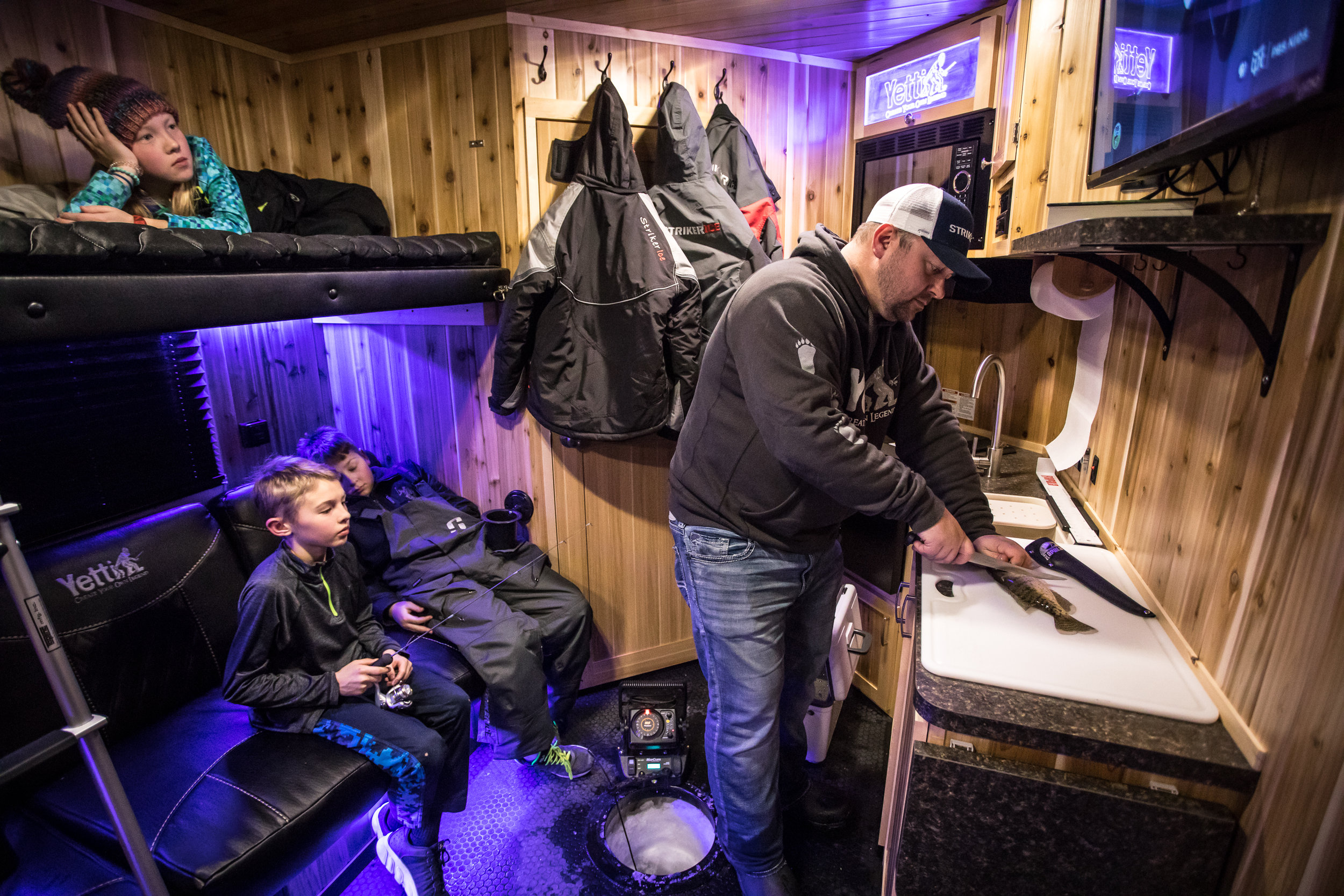While permanent fish houses have long been a fixture on Minnesota’s frozen waters, the rise in wheelhouse ownership across the state and beyond is readily apparent each time you drive by your favorite lake. Long-time ice anglers and casual summer anglers alike are drawn to the ice by convenience, effectiveness, and the fun “camping” aspect that is wheelhouse fishing. I thought it would be a good idea for new anglers and old to review some regulations, but also get the straight scoop from a warden on how to best observe fish and game laws as they pertain to wheelhouse and permanent shelter fishing. Kylan Hill, Conservation Officer (CO) from the Zumbrota, MN station helped answer a few of my own questions, and gave insight on what to expect when being checked on the ice.
“First off, anglers need an up-to-date shelter license for any non-portable shelter, with a portable shelter meaning something that is collapsible or foldable,” Kylan mentions. “Even if occupied continuously, wheelhouses, skid-houses, and any non-portables need that shelter tag, including portables that are left on the ice overnight,” he continues. Per regulations, you must also display the fish-house shelter tag you receive, along with name and address, or driver’s license number, or MN DNR identification number. Kylan recommends the latter saying, “most anglers prefer to be discreet where possible, and it’s usually best to put it near the door or a window where it’s most visible.”
All of the above requirements are visible from the outside of the shelter, whether occupied or not, but what to expect when visited by a Conservation Officer while you are fishing? Kylan offers, “we always first just knock on the door and announce ourselves.” From there CO’s make sure everyone fishing has a valid license on their person. “It’s probably one of the most common violations,” Hill says, “but with all of the digital means from your phone along with hard-copy options, there’s no excuse not to have a proof of license purchase with you.” That can mean a screenshot image of your fishing license, a PDF of an online copy, or some of the more traditional methods as well, but either way, you will need it if you are fishing.
Your average check starts with licenses, but moves to fish, especially if fishing has been good. Kylan states “CO’s are allowed to inspect coolers, conveyance, or containers that could hold a wild animal,” which in a fishhouse could mean about anything, including the kitchen sink. “We’ve found fish in snowbanks, cupboards and cabinets, even toilets,” Kylan says, “and we keep an eye out for such violations, especially if there’s suspicious activity, obvious signs of fish cleaning, blood, or other observations that would lead us to believe fish are being kept.” Remember that by engaging in a regulated activity like fishing, you are obligated to show your license and cooperate by showing your catch. “Failure to do so results in a citation, and most anglers cooperate,” says Hill.
Pay particular attention to any lakes with special regulations, especially if you are keeping, cleaning, and/or eating those fish. Anglers must observe possession and length-limits specific to their lake of choice. Those regulations are clearly posted at public accesses, and published in the regulations booklet you get with your license. Hill offers, “You can always use your smart phone to research regulations as well, so especially these days, there’s few excuses for not knowing the regs for the lake you’re fishing. A quarter of an inch over is still over, and anglers should measure carefully to avoid a citation.”
Hill also says, “You can’t possess dressed fillets in a fish house on special regulations lakes, even if a skin tag is attached; unless they’re prepared by a licensed fish packer, or you have legal length, fully intact carcasses to measure.” Kylan states a key point, “Remember that if you’ve caught, cooked, and eaten a limit of a certain species, you’re done fishing for that day.” He continues, “If an angler does choose to clean fish on the lake, they must be in the process of cooking them at the same time, as-in, hot oil in the pan.” Bottom line, if you are going to cook and eat fish that you catch on the ice, you must fillet and immediately eat while saving all carcasses from your take.
Of course, any illegal activity regarding drugs or alcohol is subject to enforcement action, yet among some of the many illegalities officers observe in the field. Hill says, “anglers sometimes get a bit too comfortable in their ice houses, and bring illegal substances and activities from home.” It is good to remember that you’re on a public waterway for that reason, whether in the house, or outside on a snowmobile, ATV, or other ice vehicle. Kylan mentions, “a good number of our checks involve making sure that vehicle licensing, registration, and safety equipment like helmets are in order. Overall, safety is a great concern of ours out on the ice, so a safety checklist goes a long way. For out on the open ice, picks, cleats, and a float suit or PFD are great items to have. Inside of the house, a fire extinguisher and carbon monoxide detector is key, especially for home-made houses,” says Hill.
From an angler perspective, I’ve been checked on the ice and believe respect to be a mutual commodity. “Most anglers are great to deal with on ice,” offers Kylan, “but those who scramble inside of a fish-house when we knock on the door, or are uncooperative from the start usually raise a red flag. As peace officers that protect our fish and game, it’s our duty to take those observations and dig deeper.” Honesty is the best policy, and playing it straight from the get-go is the order of the day when meeting with an officer. Kylan recalls, “I had a guy a few weeks ago that walked out of his house, saw me on the ice, then turn on a dime to run inside and shut the door. I could hear him running around the house reeling up lines from outside the shelter, and knocked on the door to check him. He said he had 2 lines down at first, but admitted to ‘three or four’ after I pressed him a bit.”
Avoiding suspicion is usually easy provided you’re not involved in suspicious activity I’ve found, and it’s always good to remember that observing fish and game laws is about more than just staying legal, it’s to promote the safety of our anglers and the future of our resource.






